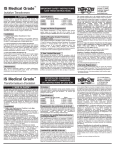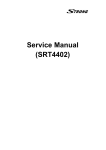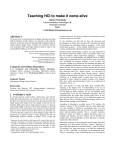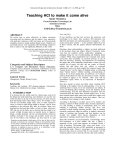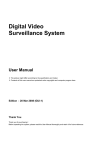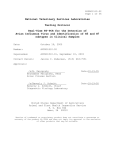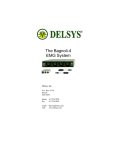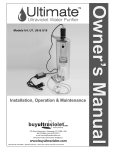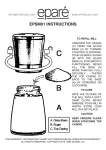Download TRIGNO Wireless System User's Guide
Transcript
TrignoTM Wireless System User’s Guide Delsys Inc. P.O. Box 15734 Boston, MA 02215 phone: 617 236 0599 fax: 617 236 0549 email: [email protected] web: www.delsys.com TM TRIGNO Wireless System User’s Guide October 2010 Edition PM-W01 Copyright © 2010 by Delsys Incorporated Specifications and procedures outlined in this document are subject to change without notice. Delsys Logo, EMGworks, and Myomonitor are Registered Trademarks of Delsys Incorporated. MAN-012-2-0 Table of Contents Table of Contents ....................................................................... 1 Important Information ................................................................. 3 Intended Use........................................................................ 3 Contraindications ................................................................. 3 Technical Service and Support ............................................ 3 Warnings and Precautions ................................................... 4 Device Information ............................................................... 5 Disclaimer ............................................................................ 7 Limited Warranty .................................................................. 7 System Requirements.......................................................... 7 TrignoTM Wireless EMG System Overview ............................... 8 Wireless EMG Sensor.......................................................... 8 Sensor LED Indicator Status ......................................... 9 Base Station......................................................................... 9 Power Supply ..................................................................... 10 Getting Started with the TrignoTM System............................... 11 Powering the Base Station................................................. 11 Connecting the Base Station ............................................. 11 Charging the Sensors ........................................................ 11 Turing the Sensors ON ...................................................... 13 Turning the Sensors Off ..................................................... 13 Configuring the Trigno System ................................................. 14 Software Installation and Configuration ............................. 14 Trigno System Information ................................................. 15 Trigno System Settings ............................................... 17 Trigno Sensor Status Console ........................................... 18 Using the Wireless EMG Sensors ............................................ 19 Orienting the EMG Sensors on the Skin ............................ 19 Cleaning the Sensor Site ................................................... 19 Applying the Trigno Adhesive Skin Interfaces ................... 19 Sensor Pairing ................................................................... 20 Sensor Factory Calibration ................................................ 21 Smart Sensors ................................................................... 22 Sensor Modes .................................................................... 22 Data Collection................................................................... 22 Using the Analog Outputs......................................................... 24 Analog Output Connectors................................................. 24 Channels 1 - 16, EMG Signals .................................... 24 Channels 1-64, all Signals........................................... 24 Screw Terminal Connections....................................... 25 Analog Output Software ..................................................... 26 Test Panel ................................................................... Sensor Modes ............................................................. Using Tandem Trigno Systems ................................................ Initial Connectivity........................................................ Communication Frequencies....................................... Synchronization ........................................................... User Interface .............................................................. Maintenance and Care ............................................................. Trigno Sensors................................................................... Trigno Base Station ........................................................... Specifications ........................................................................... Trigno Sensors................................................................... Trigno Recharging Base Station ........................................ Appendix I................................................................................. Mains Isolation ................................................................... Appendix II................................................................................ DC-A22 Unterminated Output Cable ................................. Installation .......................................................................... DC-A22 Conductor Assignments ....................................... 26 28 29 29 29 29 30 31 31 31 33 33 35 36 36 37 37 37 38 Important Information Intended Use The TrignoTM Wireless EMG Systems are designed for research, investigational and scholarship purposes only. Delsys® products are not intended for measurement purposes or for use in the treatment and diagnosis of humans. Rx ONLY Contraindications DO NOT USE on Patients with implanted electronic devices of any kind, including cardiac pace-makers or similar assistive devices, electronic infusion pumps, and implanted stimulators. DO NOT USE on irritated skin or open wounds. DO NOT USE on Patients with allergies to Silver. Technical Service and Support For information and assistance visit our web site at: www.delsys.com Contact us at: E-mail: [email protected] tel: (617) 236 0599 3 Warnings and Precautions Consult all accompanying documents for precautionary statements and other important information. Consult accompanying user’s guide for detailed instructions. Keep the device dry. The presence of liquids may compromise the safety features of the device. Handle with care. Sensitive electronic device. Avoid static discharges. Do not operate or store near strong electrostatic, electromagnetic, magnetic or radioactive fields. Interference from external sources may decrease the signalto-noise ratio or result in corrupted data. Connect only to Delsys-approved devices. Connecting a patient to high-frequency surgical equipment while using Delsys EMG systems may result in burns at the site of the EMG sensor contacts. Immediately discontinue device use if skin irritation or discomfort occurs. Immediately discontinue device use if a change in the device’s performance is noted. Contact Delsys technical support for assistance. Delsys Inc. guarantees the safety, reliability, and performance of the equipment only if assembly, modifications and repairs are carried out by authorized technicians; the electrical installation complies with the appropriate requirements; and the equipment is used in accordance with the instructions for use. Device contains a Lithium-Polymer battery. Do not damage, crush, burn, freeze or otherwise mishandle the device. Recharge only with the approved power supply and recharger. Trigno Systems should be stored and operated between 5 and 50 degrees Celsius due to the presence of an internal Lithium Polymer rechargeable cell. Storing or operating the device, and consequently the cell, outside of this temperature range may compromise the integrity and the safety features of the cell. 4 TrignoTM Wireless System User’s Guide Device Information Complies with Requirements put forth by the Medical Device Directive 93/42/EEC. Class I device, Annex VII. Type BF device (IEC 60601-1). Isolated device, (Class II, IEC 60601-1) Do not dispose this product with house waste. Contact Delsys Inc. for instructions on responsibly disposing this device. This product should not be mixed with other commercial wastes. Date of Manufacturing (appears on device) Serial Number (appears on device) EC REP EMERGO EUROPE Molenstraat 15 2513 BH, The Hague The Netherlands Authorized Representative DELSYS INC. 650 Beacon St. Boston MA 02215 USA Manufacturer FCC ID: W4P-SP-W02 (Trigno Base Station) FCC ID: W4P-SP-W01 (Trigno Sensor) IC: 8138A-DST01 (Trigno System) This device complies with Part 15 of the FCC Rules. Operation is subject to the following two conditions: (1) This device may not cause harmful interference. and (2) this device must accept any interference received, including interference that may cause undesired operation. This product complies with FCC OET Bulletin 65 radiation exposure limits set forth for an uncontrolled environment. Operation is subject to the following two conditions: (1) This device may not cause harmful interference. and (2) this device must accept any interference received, including interference that may cause undesired operation. 5 Changes not expressly approved by Delsys Inc.could void the User’s authority to operate the equipment To reduce potential radio interference to other users, the antenna type and its gain should be so chosen that the equivalent isotropically radiated power (EIRP) is not more than that required for successful communication. This equipment has been tested and found to comply with the limits for a Class B digital device, pursuant to Part 15 of the FCC Rules. These limits are designed to provide reasonable protection against harmful interference in a residential installation. This equipment generates, uses, and can radiate radio frequency energy and, if not installed and used in accordance with the instructions, may cause harmful interference to radio communications. There is no guarantee that interference will not occur in a particular installation. If this equipment does cause harmful interference to radio or television reception, which can be determined by turning the equipment off and on, the user is encouraged to try to correct the interference by one or more of the following measures: • Reorient or relocate the receiving antenna. • Increase the separation between the equipment and receiver. • Connect the equipment into outlet on a separate circuit. 6 TrignoTM Wireless System User’s Guide Disclaimer DELSYS INC. makes no warranties, express or implied, as to the quality and performance of this product including but not limited to, any implied warranty of applicability for other than research uses by qualified individuals. DELSYS INC. shall not be liable to any person for any medical expenses or any direct or consequential damages resulting from any defect, failure or malfunction, whether a claim for such damages is based upon theory of warranty, contract, tort or otherwise. No representative, agent, or licensed practitioner is authorized to waive this disclaimer. DELSYS INC. makes no diagnosis or prescription by virtue of anything about this product. Limited Warranty The TrignoTM Wireless EMG Systems are warranted against failure of materials and workmanship for a period of 1 year from the date of delivery, provided that the product is given proper care and has not been subject to abuse during this period. This warranty is in lieu of all other warranties expressed or implied. Operation of this device outside specifications determined by DELSYS INC. or use with any other input devices other than DELSYS INC. sensors constitute an invalidation of this limited warranty. This warranty is not transferable. System Requirements • EMGworks 4.0.2 or later • Windows 7, 32 bit operating systems only. Alternate OS: Windows Vista or Windows XP with service pack 3. • One USB 2.0 port • At least 2.0 GHz processor clock speed • At least 2 GB system memory • 1280x1024 (SXGA) display resolution or better • 1 GB hard disk storage • Users of Windows 7 and Vista can simply ensure that they have a Windows Experience Index of 4.0 or greater. 7 TrignoTM Wireless EMG System Overview The TrignoTM Wireless EMG System is a high-performing device unparalleled in its sophistication, its reliability and its ease-of-use. Each EMG sensor has a built-in triaxial accelerometer, a guaranteed transmission range of 40 m and a rechargeable battery lasting a minimum of 7 hours. The system is capable of streaming data to EMGworks Acquisition and Analysis software, and of generating 16 EMG and 48 accelerometer analog channels for integration with motion capture and other 3rd party data acquisition systems. Full triggering features further expand the possibility for integration with additional measurement technologies. Wireless EMG Sensor Each Trigno Sensor is equipped with the following features: • • • • • • • • • • • • • • • • transmission range of 40m inter-sensor latency < 500us (< 1 sample period) self-contained rechargeable battery EMG signal bandwidth 20- 450 Hz EMG signal sampling rate up to 4000 samples/sec EMG baseline noise of <750 nV RMS CMRR > 80dB 16-bit EMG signal resolution integrated triaxial accelerometer software selectable accelerometer sensitivity of ± 1.5g or ±6g LED User feedback battery charge monitoring and status indicator environmentally sealed device proven parallel bar electrode technology contoured sensor-skin interface for maximum signal stability auto shutoff Inertial Sensing Axes EMG Electrodes Figure 1. Trigno wireless 4-channel sensor. 8 TrignoTM Wireless System User’s Guide Sensor LED Indicator Status Status Data Streaming Scanning Pairing Successful Pairing Unsuccessful Mode Switch Firmware Update Battery Charging Charging Complete Charging Error Sensor Off LED Behavior Flashing green, 1 Hz Alternating green/amber flash, 1Hz Rapid green flashing, 3x, button depressed Rapid red flashing, 3x, button depressed Rapid green flashing, 3x Rapid green flashing, 3x Solid amber, in cradle Solid green, in cradle LED off, sensor in cradle, cradle powered up LED off LED Base Station 7 2 1 3 6 5 4 Figure 2. Trigno Base Station. 1 Wireless Sensor 5 Analog Output Connectors 2 Base Station 6 Trigger Port 3 USB Port 7 Antenna 4 Power Jack/Power Supply 8 EMGworks Software Each Base Station is equipped with the following features: • • • • • • • • recharging cradle for 16 sensors high speed USB communication with PC 64-channel analog output connector (16 EMG, 48 ACC) ± 5V analog output range detachable antenna full trigger capability (Start/Stop, Input/Output) communication & power feedback LEDs convenient carry case design 9 Power Supply Trigno Systems are equipped with an isolated medical grade power supply. The green power LED on the base station will illuminate when power is connected to the Base Station. The power supply is provided with interchangeable country-specific plug adapters. The power supply can be conveniently stored in the Base Station storage space when the system is not in use. Figure 3. Trigno SC-P05 International Medical Power Supply Trigno System are specifically designed and approved to function only with the Power Supply provided. Power Supply substitutions constitute a violation of the medical safety approvals and will void the warranty. If using a mains-powered PC then an additional isolation transformer is required for medical compliance to IEC60601-1. Refer to Appendix I for further details. No PC isolation is required for operation on a battery-powered laptop. 10 TrignoTM Wireless System User’s Guide Getting Started with the TrignoTM System Powering the Base Station Connect the Trigno power supply to the circular DC jack located on the side of the Base Station. Energize the power supply by connecting it to a Mains outlet or to an isolation transformer. Ensure that the PC to be used with the Base Station is connected to the same isolation transformer. Please refer to Appendix I for clarification on using an Isolation Transformer. The power LED on the Base Station will illuminate anytime power is applied. Ensure that the Base Station antenna is securely attached to the antenna connector. Figure 4. Connecting the Trigno Base Station power supply. Connecting the Base Station The Trigno Base Station communicates with a PC through the USB link. It is important to install the EMGworks software prior to connecting the Base Station to the PC. If this is not done, the “Found New Hardware” dialog will appear, and Windows will prompt for a driver location. Cancel this dialog and install EMGworks from the Delsys DVD in order to register the Trigno drivers with the operating system. Once the software is correctly installed, the PC will automatically detect the Trigno Base Station when it is connected to the USB port. Charging the Sensors Before using the system, the sensors should be fully charged by placing them in the Base Station cradle slots. Ensure the Base Station is powered and that the green power LED is illuminated. When charging, the sensor LEDs will illuminate to an amber color. Once the sensor battery is fully charged the sensor LED will turn 11 green. A blinking LED indicates an incomplete charge. Remove the sensor from the device and let it stand for 5 minutes. Cycle power on the Base Station and re-dock the sensor to restart the charge cycle. A complete charge cycle from a fully depleted sensor takes approximately 2.5 hours. Do not force the sensors into the recharging cradles of the Base Station. The sensors are keyed so that they can only be inserted in one orientation. Check the sensor orientation and check for obstructions in the cradle if physical resistance is met while cradling the sensors. Recharge only with the approved power supply (SC-P05) originally included with the system. Charging with any other power supply may damage the device and will void the warranty. Charge Complete Charging Figure 5. Sensor LED feedback for battery charging status. 12 TrignoTM Wireless System User’s Guide Turing the Sensors ON Trigno Sensors are turned on by depressing the rubber button for approximately one second. The green LED on the sensor will immediately begin to flash, and begin searching for a Base Station that has been properly paired and is within its range. If no Base Station is found, the LED will alternate between amber and green, indicating that it does not have an established communication link. As soon a link is established with the Base Station, the sensor LED will flash green approximately once per second, indicating that data are streaming. Figure 6. Turning the Trigno Sensor “ON”. Turning the Sensors Off There are several mechanisms for turning the Trigno sensors off, described as follows: • Send an “off ” command via software • Dock the sensor in an active cradle • 5 minute time-out if no base is linked • Hold sensor button for approx. 20 sec. 13 Configuring the Trigno System Software Installation and Configuration The Trigno EMG system is controlled by a PC via the USB port and thus requires specialized software. They system is shipped with a Delsys Software DVD containing both EMGworks Signal Acquisition and Analysis Software, and the Trigno Analog Output software for use with 3rd party data acquisition systems. Refer to the “Acquiring and Plotting Data” video tutorial (provided on the DVD) for a brief introduction to configuring the EMGworks software with the Trigno system. When editing a configuration in EMGworks, the hardware options for the base station can be set in the Hardware node of the Configuration Tree, after selecting the Trigno as the primary A/D device for that configuration. When using the Trigno Analog Output application, these options can be set by clicking the Configure button. Figure 7. Selecting the Trigno system as the primary A/D device in the Hardware node of the Configuration Tree. 14 TrignoTM Wireless System User’s Guide Trigno System Information The Information tab in the window relays data pertaining the to system settings. Figure 8. Trigno Wireless System information. If multiple bases are connected, the settings for each base are shown on a separate, top level tab. Transmission Frequencies Wireless communication occurs on varieties of frequencies throughout the acceptable 2.4 GHz spectrum. Four frequency sets are available (“A”, “B”, “C” and “D”). These should only be changed if wireless communication is poor for the default set “A”. Poor communication occurs if nearby sources are interfering with the operating frequencies, or if there is significant path loss on the operating frequencies. After changing communication frequencies, all sensors must be re-paired. Firmware Version Delsys may occasionally release firmware upgrades to improve and evolve the functionality of Trigno Systems. The current firmware version is shown here. Serial Number Each Trigno Base Station has a unique serial number and identifier address which is shown here. Network Size Indicates the number of sensors supported by this base. 15 Launch Test Panel Places the Trigno Base Station in a test mode for verifying the analog output connections. Each of the 64 analog output channels is configured to produce a unique sinusoid which can be verified by properly sampling these channels with a third party data acquisition system. Refer to the “Using Analog Outputs” section of this guide. Refresh This button refreshes the status information. Copy Copies the data the in the Information tab to the clipboard. 16 TrignoTM Wireless System User’s Guide Trigno System Settings The Settings tab in the Trigno Configuration window allows several system parameters to be modified as needed. Figure 9. Configuring Trigno Sensor Settings Frequency Set Use this setting to change the frequencies being used for wireless communication. The default set is “A”. The frequency set should only be changed if nearby sources are interfering with Trigno communications or the particular operating environment is causing significant path loss on the current frequency set. Note that changing the communication frequency set will require sensor re-pairing (see section on Trigno Sensor Status). Frequencies within the sets are defined by the system and cannot be changed by the User. Audible Warnings This option will generate an audible “ping” along with a small message, whenever a sensor falls out of range or it’s battery is excessively low. 17 Trigno Sensor Status Console A Status console for Trigno Sensors is available when operating EMGworks and when operating the Trigno system in Analog Output mode. The console tracks all Trigno sensors in the system in real-time, relaying their on/off state, their battery charge level and their communication quality in the network. Additionally, this console can send an “off” command to all sensors, and hosts the sensor pairing function. A compact display of this information is accessible in EMGworks by hovering over the notification area icon for the Trigno hardware. The full dialog is displayed by double-slicking this icon. Figure 10. The Trigno Sensor Status Console offers real-time sensor feedback. A) data acquisition status, B) battery charge state, C) sensor number, D) sensor power, E) wireless signal strength, F) sensor pairing, G) off command. 18 TrignoTM Wireless System User’s Guide Using the Wireless EMG Sensors Orienting the EMG Sensors on the Skin Trigno EMG Sensors are fitted with 4 silver bar contacts for detecting the EMG signal at the skin surface. It is crucial that the orientation of these bars be perpendicular to the muscle fibers for maximum signal detection. The top of the sensor is shaped with an arrow to aid in the determination of this orientation. The arrow should be placed parallel to the muscle fibers underneath the sensor. The sensor should also be placed in the center of the muscle belly away from tendons and the edge of the muscle. The sensor is easily attached to the skin using the Delsys Adhesive Sensor Interface. muscle-fiber direction Figure 11. EMG Sensors must be properly oriented with the muscle fibers. Align the sensor’s arrow with the direction of the underlying muscle fibers. Cleaning the Sensor Site Prior to affixing the EMG sensor on the surface of the skin, the sensor site must be properly cleaned to remove dry dermis and any skin oils. Wiping the skin prior to sensor application is critical. If excessive hair is present, it will also be necessary to shave the site. In cases where the skin is excessively dry, it may be useful to dislodge dry skin cells by dabbing the site with medical tape. The dry cells will attach the tape’s adhesive when it is removed. Be sure to wipe with isopropyl alcohol to remove any adhesive residue that may remain. Applying the Trigno Adhesive Skin Interfaces Trigno System are supplied with specially-designed adhesive interfaces to simplify sensor attachment. These hypo-allergenic interfaces are manufactured from medical grade adhesive approved for dermatological applications. Usage of the interface promotes a 19 high quality electrical connection between the sensor bars and the skin, minimizing motion artifacts and the ill-effects of line interference. To ensure a strong bond with the skin, it is advised to remove excessive hair and wipe the skin area and the EMG Sensor with isopropyl alcohol to remove oils and surface residues. Allow the skin to dry completely before applying the interfaces. Adhesive Sensor Interfaces are for single use only. Immediately discontinue use if skin irritation or discomfort occurs. All Adhesive Sensor Interfaces and Reference Electrodes are for single use only. Discard after using. Reseal storage bag to maintain freshness. Sensor Pairing Trigno sensors communicate with a custom wireless protocol that links each sensor to a unique Base Station. This linking process is known as sensor “pairing”, and is initiated through the “Pair” command. 1. Initiate sensor pairing in software. When using EMGworks, initiate pairing by right-clicking the Trigno hardware icon in the system notification area, and selecting the appropriate menu item. Figure 12. Location of the Trigno hardware icon in the system notification area, and the pairing menu item. 20 TrignoTM Wireless System User’s Guide When using Trigno Analog Output, click the “Pair” button on the Sensor Status Console. Figure 13. Pair button in the Sensor Status Console. 2. Complete the pairing process by depressing the desired sensor button for a minimum of 3 seconds. Successful pairing will result in 3 green LED flashes on the sensor, and a confirmational message in the software. Figure 14. Complete the process by depressing the sensor button for 3 sec. Trigno systems are shipped with all sensors appropriately paired. Sensor pairing is typically needed if sensors are being replaced within the network group, when the communication frequency sets are changed, and after a firmware upgrade is performed. Sensor Factory Calibration The system stores calibration information for sensors which have been paired with it. When collecting data with EMGworks, this calibration information is used to accurately display measured values, in many cases without the need for a user-initiated manual calibration. After a pairing operation is completed, the system automatically searches for pre-existing factory calibration data on the particular sensor. If the sensor has never been paired with the system (for example, in the case of a new additional sensor), the software will prompt the user to enter factory calibration data, which can be obtained from Delsys. Factory calibration data are a string a numbers and letters which encode the calibration values for a 21 specific sensor. Factory calibrations are specific to a single sensor and will not be accepted by the software for use on another sensor. At any time a nominal, “default” calibration may be selected for a sensor, or the specific factory calibration may be re-entered. This feature is accessed by re-pairing the sensor. Figure 15. Factory Calibration Prompt. The calibration can be either autodetected, or entered manually if the sensor is being paired for the first time. Smart Sensors After pairing, the association of sensors to the base station is retained for all future uses. Any configuration in EMGworks can be made to reflect the last paired set of sensors by clicking the “Refresh Smart Sensors” button in the “Add Sensors” pane in EMGworks. When data collection starts, the software will verify that the sensors currently communicating match those used in the configuration. If there is a mismatch, cancel the recording and repair the sensors. Sensor Modes Each Trigno sensor can operate in one of 4 possible data collection modes, which determines the type of data being collected. When using EMGworks, the sensor mode can be set on the sensor settings pane for each sensor. Note that the number of modes available is determined by the Trigno sensor type. Figure 16. Setting sensor modes in EMGworks. Data Collection Refer to the EMGworks documentation (accessible in the Help menu of the software) for detailed instructions on setting up data 22 TrignoTM Wireless System User’s Guide collection in EMGworks. Whenever data are collected in EMGworks, the analog outputs on the base station are also active, so it is possible to collect data in EMGworks and in a secondary data acquisition system simultaneously. 23 Using the Analog Outputs The Trigno System provides simultaneous analog signal reconstruction of data being detected by all active sensors. These signals are made available on the 68-pin connectors located on the Base Station. EMG signals at these outputs are amplified by a factor of 909, with full dynamic range of ±5V. Similarly accelerometer signals are presented with a nominal full range of ±5V. These must be calibrated according to their selected operational range (±1.5g, ±6g). Note that these signals exhibit a fixed 48ms delay from the time the sensor detects the event to the time the analog signal is reproduced. Figure 17. Analog Output connections. Analog Output Connectors Channels 1 - 16, EMG Signals The pinout of this connector replicates the pinout of the Bagnoli desktop EMG systems to facilitate connectivity between shared equipment. Only EMG signals are provided on this connector. Note that this pinout is also compatible to that of National Instruments data acquisition modules. Channels 1-64, all Signals This connector makes available all 64 analog output channels in the 68-pin connector. This connector is compatible with some 80channel data acquisition modules from National Instruments. 24 TrignoTM Wireless System User’s Guide Figure 18. Pinouts of the Analog Output connectors. Screw Terminal Connections Many data acquisition systems are equipped with screw-type wire terminations. In these cases Delsys can supply a cable assembly that mates with the Trigno Analog Output connectors and breaks out the individual channels onto single conductors. Please contact Delsys for details regarding this particular wire assembly or other connectivity needs. Please refer to Appendix II for further details regarding the DC-A22 Unterminated Output Cable. Figure 19. DC-A22 Unterminated Output Cable. 25 Analog Output Software Included with the Delsys software package is the Trigno Analog Output software, which operates on a PC independently from EMGworks Data Acquisition and Analysis software. The Trigno Analog Output Software is designed to configure and control the Trigno System so that it becomes a full analog instrument. In this scenario, all data acquisition is performed by sampling the analog channels with 3rd party acquisition systems, often used with Motion Capture Systems. The Trigno Analog Output application must remain running on the PC for the analog outputs to remain active. The wireless sensor configuration window is accessible from the “configure” button. “Start” and “Stop” controls activate and deactivate the analog outputs, and define the Start and Stop output trigger events. All settings are locked once the “Start” button is depressed, and can only be changed after the “Stop” button is pressed. Figure 20. Trigno Analog Output software. Test Panel The Test Panel is used to verify the analog signal connections with the data acquisition module by outputting predefined and unique 26 TrignoTM Wireless System User’s Guide signals on each channel. The test signals are sinusoidal in nature and defined by an amplitude, a frequency and an offset. The expected outputs for each analog channels are listed in the Test Panel window once the option is slected. Figure 21. The Test Panel Signals. 27 Sensor Modes In the Analog Output application, the sensor mode is controlled on the Mode Control tab of the Configuration dialog. When using the Analog Output application, the 4 modes are determined by the selection of the check boxes for mode A and mode B on each sensor. These settings are independent from the range settings in EMGworks. Modes for Trigno Sensor (type 00) Mode A Mode B Interpretation +/- 1.5 g ACC Range +/- 6 g ACC Range +/- 1.5 g ACC Range +/- 6 g ACC Range Figure 22. Setting sensor modes in the Analog Output application. 28 TrignoTM Wireless System User’s Guide Using Tandem Trigno Systems Two Trigno systems may be used in tandem, connected to the same computer as a synchronized 32 sensor, 128 channel system. Initial Connectivity To use two Trigno systems in a tandem configuration, connect the USB cable from each base station to the same computer. If using EMGworks, also connect the Trigger Cross-Over Cable (DC-C02) between the trigger ports on the two base stations. After connecting the USB cables and powering each base station, launch either the Trigno Analog Output application or EMGworks. Note that the trigger cross-over cable will work irrespective of orientation. Figure 23. Installation of the Trigger Cross-Over cable to synchronize two base stations when used with EMGworks. Communication Frequencies When the software detects the presence of two bases connected to the computer, the frequency sets on each base are automatically changed to allow the simultaneous communication of 32 sensors. The user is required to re-pair each sensor to use these new communication frequencies. Similarly, when reverting to the use of a single base, the communication frequency set will be restored to the option selected by the user (Set A, B, C, or D) and the sensors must again be re-paired. Synchronization All channels of data collected in a tandem configuration are fully synchronized between the two bases. 29 User Interface User interface options are expanded to reflect the presence of additional sensors. Figure 24. The Status Console when tandem bases are used. 30 TrignoTM Wireless System User’s Guide Maintenance and Care Trigno Sensors Trigno sensor are encased in a sealed polycarbonate enclosure. The following points should be kept in mind when handling the sensors. • All sensors should be visually inspected before each use to ensure that no mechanical deterioration has occurred. • The sensors can be cleaned and sterilized with a damp cloth and mild detergent, or with 70% isopropyl alcohol swabs. Ensure that the sensor contacts remain clean at all times for proper operation. • While the sensors are sealed and are water-resistant, these should never be completely submerged in any liquid. They are design to be used on damp skin surfaces and in the presence of sweat without compromise to safety, sensor integrity or operation. • The sensor contacts are made of pure silver and are quite soft. Care should be taken to preserve the integrity of these contacts. Do not scrape or dent these contacts. • Handle the sensors with care: do not drop them on the ground or step on them. Do not submerge the sensors in any liquid under any circumstance. The sensors contain sensitive electronic circuitry. Static discharges and intense magnetic fields should be avoided to prevent the risk of irreparable damage to the sensors. Trigno Base Station The Trigno System is designed to provide years of reliable service when proper care is followed. While the Base Station enclosure is made of durable plastic, the following points should be kept in mind during its use and handling: • The device and its accessories should be visually inspected before every use to ensure that no mechanical deterioration has occurred. • The Base Station can be easily cleaned with a 70% solution of isopropyl alcohol if necessary. DO NOT EXPOSE THE BASE STATION TO ANY LIQUID. IT IS NOT A SEALED DEVICE. 31 • The units are not shockproof and should not be dropped or be subjected to excessive forces or accelerations. The recharging Base Station is not water-resistant. Under no circumstance should this unit be exposed to water or any other type of liquids. 32 TrignoTM Wireless System User’s Guide Specifications Trigno Sensors GENERAL SPECIFICATIONS Typical Operating Range (1) 40 m Transmission Source 2.4 GHz, 1 mW Power Consumption <60 mW Case Dimension 27 x 37 x 15 mm Case Material medical-grade polycarbonate (2,3) Full-charge Operation Time 8 hours Recharge Time <2.5 hours Mass < 15g Auto Shut-down timer Temperature Range (1) (2) (3) (4) (4) 300 seconds 5 - 50 degrees Celsius Range is characterized in open office environments. Interfering RF sources in the 2.4GHz spectrum, as well as absorptive objects occluding the RF communication path may degrade transmission distance. Stated range can be exceeded under favorable RF conditions. Battery duration is a function of charge and discharge conditions. Optimal battery performance is obtained when the device is operated at room temperature. Note that the stated Operation Time reflects the expected performance of a fully charged new battery used in a sensor that is transmitting data. Operation Time is expected to decrease as a function of charge cycles, and when the sensor is searching for a network. 80% of original battery capacity is maintained after 300 discharge/recharge cycles. This value represents a typical expectation under ideal conditions. Actual performance will vary depending on usage conditions. Operation beyond these temperature limits may damage the rechargeable battery. 33 EMG SENSOR SPECIFICATIONS Range (1) 11 mV (r.t.i.) Resolution (EMG Signal) (2) 168 nV/bit Bandwidth (EMG Signal)(3 20±5 Hz, >40 dB/dec 450±50 Hz, >80 dB/dec Passband Ripple(3 <2% Overall Channel Noise (4) <0.75uV CMRR >80 dB Sampling Rate(5) 2000 samples/sec 4000 samples/sec Number of Contacts 4 Contact Dimension 5 x 1 mm. Contact Material(6) 99.9% Silver (1) (2) (3) (4) (5) (6) Range is specified for the input of the EMG sensor and is samples with 16 bits Resolution is specified for the input of the sensor. Filter is designed as a maximally flat Butterworth to preserve EMG signal amplitude and phase linearity. Input-referred noise is calculated as a root mean square over a 5 second window sampled at 2kHz. EMG signal sampling rates are intrinsic to the sensor and cannot be changed beyond the two stated rates, which are software selectable. Sensor skin contacts are made from pure silver and should not be used if allergic reactions to silver are expected or found to occur. ACCELEROMETER SPECIFICATIONS Number of Axis 3 Range(1,2) ±1.5g ±6g Resolution(2) 0.016 ± 0.001 g/bit 0.063 ± 0.005 g/bit Offset Error(3) ±0.2g Bandwidth DC - 50±5 Hz, 20dB/dec Sampling Rate(4) 148.1 / 296.3 samples sec (1) (2) (3) (4) 34 Accelerometer range is software selectable. Accelerometer output is sampled with 8 bits over full range (±2g, ±7g). Readings exceeding the nominal range of ±1.5g and ±6g may be non-linear and are not guaranteed. Offset errors can nulled in software by using a calibration routine that references the normal gravitation force. Accelerometer sampling rates are intrinsic to the sensor and cannot be changed beyond the two stated rates, which are software selectable. TrignoTM Wireless System User’s Guide Trigno Recharging Base Station GENERAL SPECIFICATIONS Typical Operating Range 40 m(1) Transmission Source 2.4 GHz, 1 mW Power Consumption <10W Sensor Recharge Time < 2.5 hours USB type USB 2.0 compliant, high speed Temperature Range 5 - 50 degrees Celsius Maximum number of Sensors 16 Inter-sensor delay <500 us Dimensions 276 x 241 x 127 mm (1) Range is characterized in normal office environments. Interfering RF sources in the 2.4GHz spectrum, as well as absorptive objects occluding the RF communication path may degrade transmission distance. Stated range can be exceeded under favorable RF conditions. ANALOG OUTPUT SPECIFICATIONS Number of outputs Signal group delay 16 EMG, 48 Accelerometer (1) EMG Signal Range 48 ms ±5 V Effective EMG Signal Gain(2) 909 V/V Accelerometer Signal Range ±5 V Nominal Accelerometer Signal Gain(3) 2.42 V/g @ ±1.5g range 0.62 V/g @ ± 6 g range Channel Offset ±100 mV (max) Baseline Noise 0.5mV RMS Passband Ripple(4) <2% with Sin(X)/X correction Connector Type SCSI-68, Type II (1) (2) (3) (4) Delay from sensor event to analog output is fixed for all channels, and referenced as a “group delay”. This parameter relates the detected voltage input at the sensor to the reproduced voltage at the EMG channel output. This parameter relates the nominal uncalibrated voltage differential for an inertial displacement of 1 g. Sin(X)/X correction is applied to each channel for cancelling the distorting effects of the DAC sampling process. 35 Appendix I Mains Isolation The Trigno Base Station is provided with Medical Grade isolated power supply which is compliant with IEC60601 series of harmonized standards for Medical Devices. However, full compliance with IEC60601-1 Basic Safety for Medical Devices requires that the PC operating the software be isolated as well. This stems from the basic requirement to have all patients electrically isolated from equipment within their reach, and since the PC running the Trigno Software is conceivably within their reach, it too must be isolated. Delsys does not supply isolation transformers for Personal Computers and their peripherals. Delsys recommends model IS1000HG manufactured by Tripp Lite (www.tripplite.com) for this task. This device is a medial grade isolation transformer capable of delivering up to 1000 W. A smaller similar version for 500W is also available (IS500HG). Similar products compliant with IEC60601-1 are acceptable. 36 TrignoTM Wireless System User’s Guide Appendix II DC-A22 Unterminated Output Cable The DC-A22 Unterminated Output Cable provides access to all 64 analog output channels from the Trigno System on discrete wires for data acquisition systems with screw-type terminations. The DC-A22 cable connects directly to the output connector labeled "1-64"on the Trigno System and terminates in 67 signal conductors with pre-stripped ends (64 analog output signals and 3 GND conductors). Each conductor employs a unique color scheme to identify its signal. The conductor jacket is the primary color, and it is marked with a secondary color. An example of the coloring scheme is shown in Figure 25 below. White / Black Black / White Figure 25. Wire color scheme example. Installation Refer to Figure 26 for installing the DC-A22 cable. Please observe the following points: • Connect the GND wires to the data acquisition system ground for analog inputs. It is recommended to twist all three wires together and connect these to a common ground point on the measurement system to avoide the risk of creating ground loops. • Ensure that any unused conductors are not exposed and will not come into contact with each other or any other signal or voltage potential. This can be done by clipping the bare ends of the conductors or using heat shrink tubing or electrical tape to enclose the bare ends. 37 DC-A22 Conductor Assignments Trigno Output Trigno Pin Conductor Color Primary / Secondary Trigno Output Trigno Pin Conductor Color Primary / Secondary EMG 1 68 Violet / Orange AY 9 16 Tan / Violet AX 1 67 Blue / Orange AZ 9 17 Tan / Gray AY 1 33 Orange / Blue EMG 10 49 Blue / Tan AZ 1 34 Orange / Violet AX 10 48 Green / Tan EMG 2 66 Green / Orange AY 10 14 Tan / Green AX 2 65 Yellow / Orange AZ 10 15 Tan / Blue AY 2 31 Orange / Yellow EMG 11 47 Yellow / Tan Orange / Tan AZ 2 32 Orange / Green AX 11 46 EMG 3 64 Gray / Pink AY 11 12 Tan / Orange AX 3 63 Violet / Pink AZ 11 13 Tan / Yellow AY 3 29 Pink / Violet EMG 12 45 Pink / Tan AZ 3 30 Pink / Gray AX 12 44 Brown / Tan EMG 4 62 Blue / Pink AY 12 10 Tan / Brown AX 4 61 Green / Pink AZ 12 11 Tan / Pink AY 4 27 Pink / Green EMG 13 42 Violet / White AZ 4 28 Pink / Blue AX 13 41 Blue / White EMG 5 60 Yellow / Pink AY 13 7 White / Blue AX 5 59 Orange / Pink AZ 13 8 White / Violet AY 5 25 Pink / Orange EMG 14 40 Green / White Yellow / White AZ 5 26 Pink / Yellow AX 14 39 EMG 6 58 Gray / Brown AY 14 5 White / Yellow AX 6 57 Violet / Brown AZ 14 6 White / Green AY 6 23 Brown / Violet EMG 15 38 Orange / White AZ 6 24 Brown / Gray AX 15 37 Pink / White EMG 7 55 Green / Brown AY 15 3 White / Pink AX 7 54 Yellow / Brown AZ 15 4 White / Orange AY 7 20 Brown / Yellow EMG 16 36 Brown / White AZ 7 21 Brown / Green AX 16 35 Tan / White EMG 8 53 Orange / Brown AY 16 1 White / Tan AX 8 52 Pink / Brown AZ 16 2 White / Brown AY 8 18 Brown / Pink GND 9 White / Gray AZ 8 19 Brown / Orange GND 22 Brown / Blue EMG 9 51 Gray / Tan GND 43 Gray / White AX 9 50 Violet / Tan NC 56 Blue / Brown Figure 26. DC-A22 Conductor Assignments 38 TrignoTM Wireless System User’s Guide










































